Overall phenotypes: putting it all together
Example 1: Sugar
For example, look at Sugar in Figure 1. She has short hair that is mostly white. The colored portion of her hair is the tiger-striped pattern termed “brindle.”
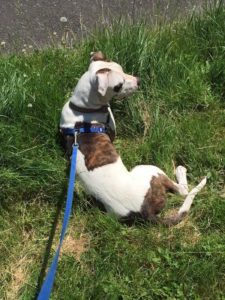
The difference between short and long hair in dogs is caused by different alleles of a gene called FGF5. This gene produces a protein that is important in regulating the hair growth cycle. When the protein doesn’t function correctly, the growth phase of the hair cycle is longer, resulting in long hair. Short hair is the dominant trait. Since Sugar has short hair, we know she has at least one dominant allele of FGF5. We can use the letter “S” for short hair. Sugar’s genotype for FGF5 is therefore “S-“, meaning she has one dominant allele and we can’t tell by looking at her what her second allele is.
Sugar’s hair is also straight, which means that she has two straight alleles of KRT71. Her genotype would be K+K+.
Sugar is more than 50% white with irregular splashes of color, which means that her genotype for MITF (the gene that controls white spotting) is sise.
The brindle pattern is caused by the kbr allele at the K locus. Sugar can’t have the KB allele or she would have solid color instead of the brindle pattern because KB is dominant over kbr and ky. She could have either the genotype kbrkbr or kbrky, since the kbr allele is dominant over the yellow allele (ky).
Sugar has black eumelanin pigment in her hair and nose. This means she has the dominant phenotype for TYPR1, so her genotype would be “B-“. Because she has eumelanin and not pheomelanin in her coat, she has the dominant phenotype for MC1R, so her genotype would be “E-“.
Sugar is a female dog who does not have hemophilia. This means that her genotype would be either XHXH or XHXh.
Putting all these together, we could say that Sugar’s overall coat genotype is S- K+K+ sise B- E- XHX–
We could potentially determine some of the unknown alleles in her genotype if we knew anything about her parents, but Sugar was adopted from the Multnomah County Animal Shelter after being picked up as a stray. Therefore, her ancestry is unknown. However, it turns out that after having her ancestry determined using DNA sequencing, she is 100% American Staffordshire Terrier.
Example 2: Rags
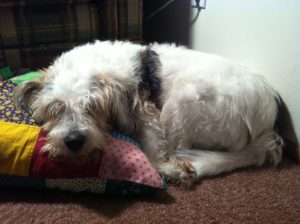
Rags has “furnishings”, a term used to describe his beard and mustache. Furnishings are caused by a mutation in the RSPO2 gene. This gene produces a protein that is involved in establishing hair follicles. The allele that leads to furnishings is dominant over the allele for no furnishings. Rags must therefore have the genotype “F-” at RSPO2. This allele also causes the long-ish hair on his legs and tail.
| Gene | Genotype | Phenotype |
| RSPO2 | FF or Ff | has furnishings |
| FGF5 | SS or Ss | short fur (his longer fur is caused by the furnishings allele) |
| KRT71 | K+K+ | straight fur |
| MITF | sise | more than 50% white |
| K locus | KBKB, KBkbr, or KBky | Solid color, not brindle or yellow. |
| TYRP1 | BB or Bb | Produces black eumelanin, not brown |
| MC1R | EE or Ee | Produces eumelanin instead of pheomelanin |
| F8 | XHY | Male, no hemophilia |
Example 3: Black poodle
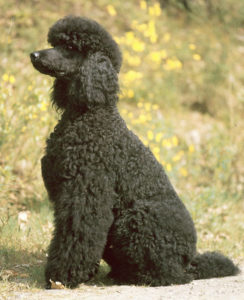
| Gene | Genotype | Phenotype |
| RSPO2 | ff | no furnishings |
| FGF5 | ss | long fur |
| KRT71 | KcKc | curly fur |
| MITF | SS | entirely solid color |
| K locus | KBKB, KBkbr, or KBky | Solid color, not brindle or yellow. |
| TYRP1 | BB or Bb | Produces black eumelanin, not brown |
| MC1R | EE or Ee | Produces eumelanin instead of pheomelanin |
Example 4: Golden Retriever
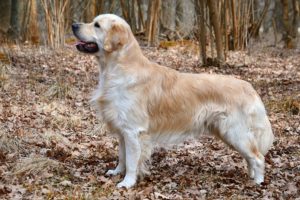
| Gene | Genotype | Phenotype |
| RSPO2 | ff | no furnishings |
| FGF5 | ss | long fur |
| KRT71 | K+K+ | straight fur |
| MITF | SS | entirely solid color |
| K locus | KBKB, KBkbr, or KBky | Solid color, not brindle or yellow. |
| TYRP1 | BB or Bb | Produces black eumelanin, not brown (seen in the nose) |
| MC1R | ee | Produces pheomelanin instead of eumelanin, so appears yellow |
But wait, there’s more!
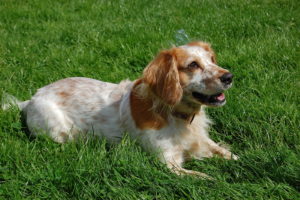
We haven’t exhaustively discussed all the genes that can affect dog appearance. For example, what gene (or genes) causes the English Springer Spaniel in Figure 5 to be red? What gene(s) cause it to be speckled on it’s back? Or lead to its freckles? There are estimated to be about 19,000 genes in the dog genome (Ostrander, 2005). The interactions of all these genes together lead to the overall phenotype of one individual dog.
If you’re interested in learning more about the genes that are involved in the appearance of dogs, check out the Dog Coat Color Genetics website at http://www.doggenetics.co.uk.
References
Unless otherwise noted, text and images by Lisa Bartee, 2016.
Ostrander EA, Wayne RK. 2005. The Canine Genome. Genome Res. 15: 1706-1716.

